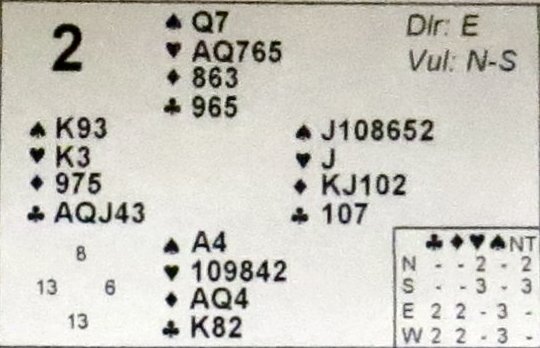The third exception bit me. Continue reading
I was sitting West for this hand, which was the last one played on a Saturday afternoon.
My partner opened 2♠ with what is a typical collection for him in the first seat at favorable vulnerability. I doubt that many of the other South’s bid 3♥, but the player at our table did. I anticipated that she would have much better hearts, which made me think that my king would be working. On the other hand, my diamond suit looked like three losers. I tempered my ambitions and bid a humble 3♠ to extend the preempt. North surprised me by bidding 4♥. The auction then came around to me. We definitely had nine spades. South probably had at least six hearts. I figured the opponents for ten in all. That would give my partner a singleton, and even if he had two, my king would probably cover one. I decided on 4♠, which was the final contract.
In the first round I would have doubled with South’s hand. If she had done so, North probably would have played 4♥, and I would have let her. If my partner could find the magical club lead, we would earn 200 points on the hand. As it was, we lost 50. There were nineteen trumps (ten for them and nine for us) but only seventeen tricks (eight for them and nine for us). The LAW says that this is unlikely in the extreme.
I was not disappointed with my partner’s inability to find ten tricks. I was disappointed to see that we had four certain tricks on defense. So, I should have passed or doubled.
There are three negative adjustments to the LAW: Negative purity, negative fit, and negative shape. These factors result in some holdings being better for defense than for offense.
The most common problem is reportedly negative purity, which is usually identified with broken honor holdings, especially in the trump suit. It is certainly true that both sides have such holdings in their respective trump suits. However, they do not result in defensive advantages. North-South can win only one spade trick on defense, and East-West has no heart tricks if that suit is trump.
In fact, after the first lead the hand plays itself. If North is declaring in hearts, and East finds the killer lead of the 10, East-West gets one spade, one diamond, and three clubs. If East is declaring in spades, North-south gets one spade, one heart, two diamonds, and no clubs. Aside from the trump suit, these are exactly the same results on both offense and defense.
The actual problem for North-South is clearly the third factor, negative shape. The two hands have identical distributions, which means that their ten trumps are not worth as much as they appear. Notice what happens if North trades a low diamond to South for a low club. They gain a trick in both suits if they are declaring in hearts, but they do not gain anything on defense. Furthermore, if North trades a low club for a low diamond, the same effect occurs!
Larry Cohen addresses this problem in To Bid or Not to Bid:
Patterns to be especially wary of are 4-3-3-3 and 5-3-3-2. If your distribution is flat, it becomes statistically more likely that the other players also are flat. If everyone’s distribution is balanced, it often depresses the number of tricks. However, flat distribution does not negatively affect the trick count as often as minor-honor problems do.
East-West has a similar problem. West’s trumps would be more valuable if they could be used for ruffing, but West has fewer cards in no side suit. My only ruffing value was in partner’s shortest suit.
What can be learned from this hand? The main thing is to be very careful about using the LAW on a hand with flat distribution. In this case, however, It was the opponents’ distributions that upset my calculation more than my own. In retrospect I asked myself “How weird (in percentage terms) was the perfect mirror imaging of the opponents’ hands?”
Start with the heart suit. South overcalled at the three level. She cannot have a solid suit; the king is in my hand. When I saw North’s raise to four, it seemed quite likely that South must have six pieces. The most likely reason for choosing a suit over a double in this position is because of an inability to support one of the suits. To be conservative, let us say that the chance of each of them having five hearts is no more than 40%. This is extremely conservative. If nothing was known about either hand other than the fact that the opponents had ten hearts between them, the probability would be 31.18%.
What about the other suits? There is really no good indication available of how any might split, so let’s consider random distributions. The probability of one of the three-card suits splitting 3-3 (assuming hearts are 5-5) is 39.16%. The probability of the other three-card suit splitting 3-3 (assuming hearts are 5-5 and the other suit is 3-3) is 47.62%. Of course, if all three of these suits split evenly, the fourth must also. The probability of all four splitting evenly is therefore no more than 7.46% under very conservative assumptions.
I made the right bid after all.


